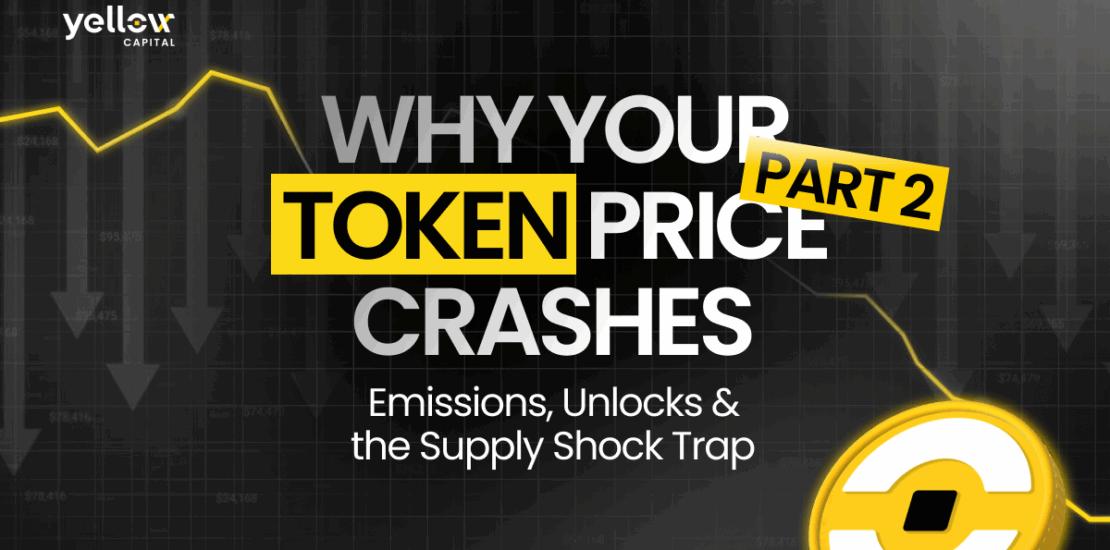- July 23, 2025
- Category: Why Your Token Price Crashes

A Founder’s Guide to Avoiding Economic Suicide in Web3
By Diego Martin, VP of Sales & Investments at Yellow Capital.
In crypto, we talk a lot about demand – how to drive adoption, utility, and engagement. But in my experience, it’s not always the lack of demand that kills a token – it’s utility. Or more precisely, poorly managed token supply dynamics.
In part one of the series, we explored foundational design errors. In this chapter, we focus on the brutal truth: if you don’t control your emissions, unlocks, or supply flexibility, no amount of community hype or product-market fit will save your token from collapsing.
Let’s break down three of the most common supply-side flaws I’ve seen destroy token value and ways to avoid them.
1. Unsustainable Emission Schedules & Hyperinflation
When token emissions outpace organic demand, you flood the market. The result? Chronic price devaluation, or what many call “death spiral”.
This happens a lot in GameFi. Early projects used high token emissions to attract users, but without mechanisms to remove tokens from circulation (sinks). The result? The ecosystem quickly became oversaturated. Rewards became worthless, utility broke down, and users left. Only short-term players dumping at every opportunity remained.
Real project examples: Take Axie Infinity’s Smooth Love Position (SLP). Emissions exploded with gameplay, while utility remained limited to breeding. As new tokens poured in and demand stagnated, the price of SLP collapsed. What started as growth turned into inflation-driven decay.
What I recommend: Don’t treat token emissions like a set-and-forget schedule. Think of them as a living system that should adapt based on demand, user activity, and treasury health. That flexibility can come from algorithmic design or community-driven governance. Just as important – set up solid token sinks early on. These are ways to take tokens out of circulation while giving them real use, like fees, access, staking, or buybacks. Make sure they grow along with your user base. And don’t just count users – watch whether your revenue is keeping up with the rewards you’re giving out. If it’s not, you’re losing value, not creating it.
Key metrics to watch:
- Inflation rate – how fast new tokens are being created compared to what’s already out there (new tokens minted / circulating supply)
- Emission-adjusted revenue – if revenue isn’t keeping up with how many tokens you’re giving out, that’s a red flag
- Token velocity without utility – if tokens are flying around but not being used for anything meaningful, it usually means people are just dumping them
2. Poorly Manages Token Unlocks & Vesting Cliffs
We’ve all seen it: a major unlock hits the calendar, and the token price tanks. But the actual unlock isn’t always the problem – expectations and fear are.
Unlock cliffs, when a batch of tokens is released at once, early investors may rush to sell and lock in profits. Traders pile on by shorting the token, speeding up the drop.
Real project examples: LAYER’s price crashed after a 13% unlock led to heavy shorting by whales. Delphi Digital reports that 90% of token unlocks lead to price drops, especially when they involve team or investor tokens.
But it’s not all bad. Well-structured unlocks can act as a stress test. If a project survives, it often signals real strength – resilient community, smart treasury management, and healthy governance.
What I recommend: Skip the cliffs. Use slow, steady vesting that rewards long-term commitment. But timing isn’t everything – be upfront about your unlock plan early. Don’t bury dates or create artificial hype. Set clear expectations.
Near big unlocks, consider working with market makers to help absorb sell pressure and keep liquidity stable. And if your protocol brings in revenue, consider using part of it for buybacks. That helps support the price and shows confidence.
Key metrics to watch:
- Public token unlock calendars
- On-chain movement from investor / team wallets
- Unlock size as % of circulating supply
3. Inflexible Supply Models
Some founders think a fixed supply makes their token more attractive. And yes, scarcity can help, but being too rigid can backfire.
Markets change. Ecosystems grow. Incentive structures evolve. If your tokenomics can’t adapt, you’re flying blind in a volatile environment. You can’t respond to demand shifts, fund ecosystem development, or support long-term incentives.
Real Project Examples: ApeCoin has a fixed 1B supply with no burn or minting mechanisms. That rigidity limits its ability to adjust to a declining BAYC ecosystem. Bitcoin’s fixed supply works because of its unique status, but that model doesn’t suit most utility or ecosystem tokens.
What I recommend: Token supply should not be a decision made once and forgotten. Instead, design with adaptability in mind. That means having governance-enabled controls over supply levers – like inflation rates, burn mechanisms, or minting limits. You may not need to use them immediately, but the ability to evolve is essential for resilience. And most importantly, be clear and transparent about your long-term vision: whether your token aims to be deflationary, disinflationary, or maintain moderate inflation, your community should know how your supply strategy aligns with ecosystem goals.
Key metrics to watch:
- Supply flexibility (mint / burn functions)
- Governance controls over emissions
- Responsiveness to usage growth or market shifts
Token design is economic policy. It’s not just about what looks good in whitepaper – it’s about how your system behaves in the wild. And nowhere this is more visible than in supply mechanics.
At Yellow Capital, we work with founders every day to design token models that can survive – not just launch. Because in crypto, survival is the first step to success.
Stay tuned for part 3, where we’ll explore demand-side fragility and the risks of utility without value accrual.
Add a comment
You must be logged in to post a comment.

